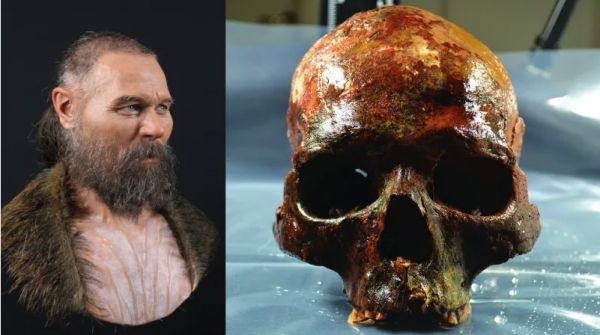Neatorama |
- Live Aid: The Complicated History of the World's Biggest Charity Concert
- Office Supplies
- Why Fireworks Scare Some Dogs but Not Others
- Widow Donates Her Kidney To Man Who Was Saved By Her Husband’s Kidney
- Facial Reconstruction of a Prehistoric Man Whose Head Was Mounted on a Stake
- Drive-In Haunted House
- How Are Eggs Eaten Around The World
- A Gigapixel Scan of da Vinci’s The Last Supper Can Now Be Seen Online
- Investigating The Mysterious Tunguska Event
- The “Superhuman” Tarahumara Runners
- Xena: Warrior Princess Ball Gown
- This AI Was Trained To Star In A Sci-fi Movie
- Here’s How You Can Stop Your Glasses From Fogging While Wearing A Mask
- Future Lunar Toilet Contest
| Live Aid: The Complicated History of the World's Biggest Charity Concert Posted: 27 Jun 2020 10:52 PM PDT Bob Geldof organized the charity single "Do They Know It's Christmas" in 1984 in raise money for famine relief in Ethiopia. It raised more than $28 million, but it wasn't enough, so he decided to go bigger the next summer with an all-star concert. Thirty-five years later, Live Aid is still considered to be the biggest music event ever, featuring 50 of the music industry's biggest stars on two continents. It wasn't easy to pull off. "He had to call Elton and say 'Queen are in and Bowie's in,' and of course they weren't," production manager Andy Zweck told The Guardian of Geldof's tactics. "Then he'd call Bowie and say 'Elton and Queen are in.' It was a game of bluff." Read about the production of Live Aid, some of its unique stories, and its lasting legacy at Mental Floss. |
| Posted: 27 Jun 2020 10:52 PM PDT
|
| Why Fireworks Scare Some Dogs but Not Others Posted: 27 Jun 2020 10:51 PM PDT The Fourth of July always brings us warnings about keeping dogs indoors, because many of them are terrified of fireworks. It's the loud sounds that spark their fear, which you might also notice during thunderstorms. But some dogs are so nonchalant about booming noises that they can carry out their duties during a bomb attack or open warfare. What makes the difference between the two types of canine reactions?
But that's just one factor. There are quite a few others that can determine how a dog reacts to fireworks, which you can read about at Smithsonian. They also have a technique you can try to help your dog become less fearful. |
| Widow Donates Her Kidney To Man Who Was Saved By Her Husband’s Kidney Posted: 27 Jun 2020 10:50 PM PDT
Sometimes love just finds a way to continue even beyond death. This story is a great example of that. This husband and wife may not have been together for a long time, but at least a part of them will still be together even beyond death. Bryan Herrington died 16 years ago in a work accident, leaving his wife Terri widowed. A man named Jeff Granger received Bryan's kidney, and along with it, a new friendship. Jeff became friends with Terri and her two small children, and everything was fine until last year, when the kidney began to fail. "The first thing that crossed my mind was, golly, how am I going to tell Terri that Bryan's kidney is failing?" Jeff said. "It was like, 'OK, well, that's another piece of Bryan that has gone,'" Terri said. Terri said she didn't want to lose her husband all over again — not to mention her new friend. So without hesitation, she offered her kidney, to continue the life-saving mission her husband had started. And so Terri continued the legacy that her husband left behind. By sheer coincidence, they were a match, and the operation at the University of Florida Health Shands Hospital was a success. Now the kidneys – from both husband and wife — lie side by side, together in purpose – all thanks to the silver lining that is organ donation. "Seeing him going fishing and boating and just living life, it's just an amazing feeling that you're helping somebody," Terri said. [...] "They live together in me, so I'll try to keep 'em alive as long as I can," said Jeff Granger. Very wholesome. (Image Credit: UF Health/ CBS News) |
| Facial Reconstruction of a Prehistoric Man Whose Head Was Mounted on a Stake Posted: 27 Jun 2020 05:42 PM PDT
Crime is much more meaningful when you can relate personally to the victim (or the killer, if you are that sort). We may find it hard to personally relate to people who died 8,000 years ago, but at least now we can put a face on one man whose head was erected on a stake after he was killed in a violent manner.
Swedish forensic artist Oscar Nilsson reconstructed the man's face from the blues in his DNA, evidence from the archaeological site, and what we know of the area's history. Read how he did it at Gizmodo. |
| Posted: 27 Jun 2020 12:19 PM PDT
Experience the fear and thrills as you're strapped into your seat! This haunted house in Tokyo, Japan is now letting customers experience the full haunted house thrill via drive-in. Hideous creatures drenched in blood will swarm towards guests in their cars. Producer Kenta Iwana believes that this new format might be scarier than a traditional haunted house, as Rappler details: "At the drive-in haunted house, guests are confined in a car so they can't escape the horror until the end," he said. "It makes it even more scary for them." Iwana came up with the drive-in solution after struggling with a string of cancellations as the coronavirus outbreak took hold. "It's because a haunted house creates an environment with three Cs," he said, referring to the conditions Japanese experts warn risk spreading the virus: closed spaces, crowded places, and close-contact settings. "Orders for conventional-style haunted houses were cancelled one after another and we lost about 80% of our clients." The squad is usually hired to set up haunted house experiences at amusement parks and similar venues. A normal experience might involve a windowless facility with actors playing ghosts quietly following visitors and whispering directly into their ears to scare them -- all impossible in the age of coronavirus. image via Rappler |
| How Are Eggs Eaten Around The World Posted: 27 Jun 2020 12:19 PM PDT |
| A Gigapixel Scan of da Vinci’s The Last Supper Can Now Be Seen Online Posted: 27 Jun 2020 11:39 AM PDT
Tech giant Google has recently made available online a high-resolution scan of one of Leonardo da Vinci's iconic artworks — The Last Supper. The high-resolution scan of the oil painting was made possible by a partnership between Google Arts & Culture and England's Royal Academy of Arts. The scan can be viewed here. Google applied its Art Camera to scan The Last Supper, and 19 other works from the Royal Academy, in "gigapixel" resolution, creating a final image with over one billion pixels. With the new scan, users can zoom into the image as if observing it from inches away, as artnet News reports. The oil painting held by the Royal Academy, however, is not attributed mainly to da Vinci, but rather to his pupils Giampietrino and Giovanni Antonio Boltraffio, as the original quickly faded after it was completed, since Leonardo only painted it using egg tempera and oil paint on plaster. The painting has been a useful resource for scholars because it is about the same size as the original Leonardo, though it lacks the top third of the piece, and it hasn't faded as severely with time. The students' copy was even used as a reference when the original was restored between 1979 and 1999. Yet another copy, this one painted by Leonardo himself, was rediscovered in 2018 and likely created based on the same cartoon—a full-scale guide—as the mural. Learn more about the copy of da Vinci's The Last Supper, as well as its slight differences with the original, over at Smithsonian Magazine. (Image Credit: Smithsonian Magazine) |
| Investigating The Mysterious Tunguska Event Posted: 27 Jun 2020 06:37 AM PDT
On one June morning in the year 1908, something bright and hot suddenly appeared in the skies over a forest in the Siberian Taiga. It was so hot that a hunter near the Middle Tunguska River tore his shirt, as he thought that it was on fire. Locals have testified to seeing a "fiery ball go north." What happened next was catastrophic. A loud explosion, releasing the equivalent of three to five megatons of TNT, followed. The resulting shock wave, the largest in recorded history (185 times more powerful than the Hiroshima bomb), spread out over 1,000 square miles. Some 30 people were in the vicinity. Many of them were knocked unconscious, and at least three were killed. Houses and millions of trees toppled over and charred. Somehow, hours later, astronomers in Europe and Asia witnessed a night sky so bright that, "at midnight," according to one testimony, "it was possible to read the newspaper without artificial lights." This event was later known as the "Tunguska event", and it remains a mystery up to this day because it left no trace whatsoever. After decades of scientific expeditions, no one has found a crater or any debris from a meteorite or comet—nothing to conclusively indicate a violent collision with the Earth. Numerous theories have been made throughout the years, and many of them were deemed implausible. In their 2008 book, The Tunguska Meteorite: 100 Years of the Great Puzzle, authors A.I. Voitsekhovskii and V.A. Romeiko catalog 66 theories about the event. Now, a new theory has been created by a pair of scientists from the Kirensky Institute of Physics in Siberia. They argue that the cause of the mysterious event was a rare type of meteor. Check out their theory over at Nautilus. (Image Credit: Wikimedia Commons) |
| The “Superhuman” Tarahumara Runners Posted: 27 Jun 2020 06:37 AM PDT
Back in 2009, in the book Born To Run, Christopher McDougall described the Tarahumara, a tribe that lives in the canyons of northwestern Mexico, as a tribe of "Stone Age superathletes", because they can run great distances of very steep terrain "without even breaking a sweat." Born to Run also introduced the wider world to a Harvard anthropologist and evolutionary biologist named Daniel Lieberman, whose research on the evolutionary origins of running led him to hypothesize that even modern humans would be better off running either barefoot or with minimally supportive shoes. Colorful tales of the Tarahumara mixed with Lieberman's scientific cred made for a potent combination, and interest in barefoot and minimalist running exploded after the publication of McDougall's book. In the years since, there have been critical reappraisals of the case for minimalist running. Now, in an article in the journal Current Anthropology titled "Running in Tarahumara (Rarámuri) Culture: Persistence Hunting, Footracing, Dancing, Work, and the Fallacy of the Athletic Savage," a team of anthropologists take aim at the myths and misunderstandings that have arisen over Tarahumara running culture. The lead author? None other than Daniel Lieberman. Are the Tarahumara people really "born to run", just like what the title of McDougall's book suggests? What is their secret to running a hundred miles? Know the answers over at Outside Online. (Image Credit: Carl S. Lumholtz/ Wikimedia Commons) |
| Xena: Warrior Princess Ball Gown Posted: 27 Jun 2020 06:36 AM PDT Cosplayer Bernadette Bentley has played various creative versions of Xena for years. Her latest is one of her best: Xena as a warrior princess ready for the ball. The dress is hard to wear, so don't expect her to jump and flip like Lucy Lawless does: First time I wore this I had 1 plastic hoop skirt and 2 giant crinolines to hold the weight of the skirt(it's reeeeeally heavy!) and still have the princess poof ... the updated version has a much stronger and larger hoop skirt with only 1 crinoline that had to have 1 layer cut out and now it actually doesn't touch the ground which makes it easy not to trip on 😂😂. It's much easier to maneuver but still really heavy— but dang do the chains look amazing! . |
| This AI Was Trained To Star In A Sci-fi Movie Posted: 27 Jun 2020 06:36 AM PDT
An AI robot named Erica will star in a $70m sci-fi film set backed by Bondit Capital Media (the financiers behind the Oscar-nominated Loving Vincent) and New York's Ten Ten Global Media. Erica was trained in method acting by the Japanese scientists who created the robot. FastCompany has the details: "In other methods of acting, actors involve their own life experiences in the role," Sam Khoze told THR. "But Erica has no life experiences. She was created from scratch to play the role. We had to simulate her motions and emotions through one-on-one sessions, such as controlling the speed of her movements, talking through her feelings and coaching character development and body language." Producers filmed some of Erica's scenes in Japan last year. The film is still without a director and human costars, but producers are planning on shooting the rest in Europe next summer. image via The Hollywood Reporter |
| Here’s How You Can Stop Your Glasses From Fogging While Wearing A Mask Posted: 27 Jun 2020 06:36 AM PDT
Wearing a mask is essential in these trying times. It is for our own protection and safety. If you're one of those people who are having trouble with your glasses getting foggy while wearing a mask, you're not the only one! The Verge shares a couple of tips that can keep your glasses clear while wearing a mask. Check their list here. image via The Verge |
| Posted: 27 Jun 2020 06:35 AM PDT
Help NASA build the future lunar toilet, and win a huge amount of prize money! The future toilet is part of the space organization's Artemis program to land the first woman and the next man on the moon by 2024. The Artemis project aims to establish a presence that will enable eventual crewed journeys to mars. So where does the toilet contest come into place? NASA needs space toilets designed for lunar gravity, as Designboom details: although space toilets already exist and are present at the international space station, they are designed for microgravity only, but NASA needs them for lunar gravity too. this is why NASA is calling on the global community to share their novel design concepts for compact toilets that can work in both microgravity and lunar gravity. they are looking for a next-generation device that is smaller and more efficient the lunar toilet challenge is for both adults and children, and has a total prize purse of $35,000 that will be shared among the teams submitting the top three designs in the technical category. the top three participants in the junior category will each receive public recognition and an item of official NASA merchandise. image via Designboom |
| You are subscribed to email updates from Neatorama. To stop receiving these emails, you may unsubscribe now. | Email delivery powered by Google |
| Google, 1600 Amphitheatre Parkway, Mountain View, CA 94043, United States | |










No comments:
Post a Comment
Keep a civil tongue.